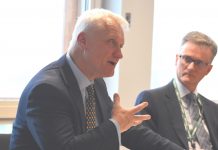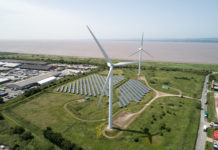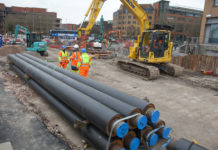 The National Audit Office has confirmed persistent industry criticism that Ofgem has been too generous with regulated energy networks, allowing them to make excess profit for eight years.
The National Audit Office has confirmed persistent industry criticism that Ofgem has been too generous with regulated energy networks, allowing them to make excess profit for eight years.
The spending watchdog said bill payers will have overpaid by up to £800m, while the eight-year ‘RIIO-1’ price control has secured too few improvements. “Customers have been locked into paying higher prices for longer”, stated the NAO.
The UK power grid is mostly owned by US and Chinese investment groups. Those excess returns will therefore have flowed from household electricity bills to investors including: Berkshire Hathaway, Cheung Kong Group, Commonwealth Bank of Australia, the Li Ka Shing Foundation, Power Asset Holdings Limited and PPL Corporation.
Britain’s licensed grid and distribution operators currently collect annual revenues of around £8 billion for keeping the lights on. But according to the public auditor, Ofgem failed to secure value for money by creating a framework that led to:
- too low performance targets
- too generous estimates of sums needed to spur network upgrades, leading to underspending on ‘excessive’ investment budgets.
- higher than expected profits
From the outset, too generous cost modelling was chief among Ofgem’s faults, said the NAO. In direct consequence, network operators have posted returns as high as 9 per cent in real terms, four points or more, the NAO noted, above a typical UK corporate benchmark.
Uncorrected since design, up to 1.5 per cent of that figure incentive was intended to spur network performance, including avoiding power cuts. But in designing its framework, Ofgem ignored available evidence on outage risks, said the NAO, and fixed its targets too far in advance. Networks were already surpassing intended goals even before the price control took effect, according to the watchdog.
Reaping this regulator-supervised windfall, the NAO noted that four of the nine DNOs have handed cash back to investors, either in share buy-backs or debt redemption.
In ‘steady-state’ technical and operational terms, the NAO admits that RIIO-1 has lived up to most of its ambitions. Network resilience is high, the UK suffers fewer outages than EU neighbours, and delivery of customer support and environmental measures is good. But upgrades towards future-proofing are still slow or lacking.
The report adds to criticism of the regulator’s economic oversight, though suggests the scale of the state sanctioned bonus is lower than calculated by Citizens Advice. The charity claimed in 2017 that networks would make £7.5bn in excess profit over the eight-year price control – though that included the gas networks.
With the next price control period coming into view, the NAO watchdog urged Ofgem to be less generous.
In response, industry lobby the ENA said the current price control had resulted in a “world class grid … a result of significant amounts of investment being made by network companies. Network costs are down almost a fifth, power cuts are shorter and less frequent than they ever have been, and the UK has become a superpower of renewable energy”.
Ahead of the next price control, the networks want Ofgem to allow spending to cope with electrification of heat and transport.
The Committee on Climate Change argues that DNOs should be allowed to future proof networks if they are being upgraded anyway, to save money in the long run.
Related stories:
Citizens Advice: Energy networks being allowed to make billions in excess profit
Ofgem: DNOs must make progress with flexibility this year
Net zero: Let DNOs install fatter wires, says Committee on Climate Change
Click here to see if you qualify for a free subscription to the print magazine, or to renew.
Follow us at @EnergystMedia. For regular bulletins, sign up for the free newsletter.




Currently, 37% of a customer’s energy bill is the useful bit’ at around £32/ Mwh.r The level is predicted to stay at about the same value.
The proportion of the delivered cost that is probably regulated is 32%
This element is on an upward trend, even before the 2021 policies kick in.
With the ever-increasing pressure on end-users to use more electricity and less on-site fossil fuels network demands are ramping up. {Not forgetting EV charging ]
And as you can see these notes do not mention gas systems.